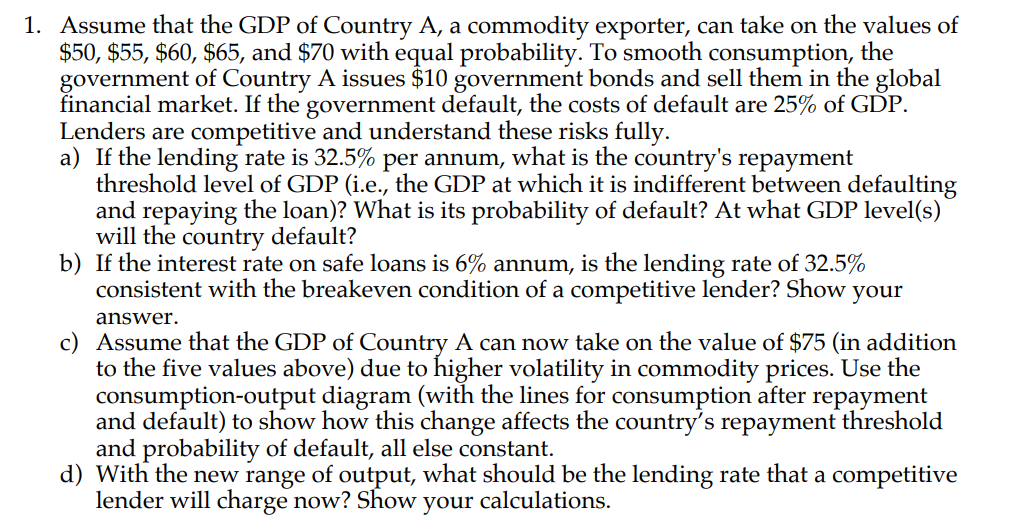1. Assume that the GDP of Country A, a commodity exporter, can take on the values of $50, $55, $60, $65, and $70 with equal probability. To smooth consumption, the government of Country A issues $10 government bonds and sell them in the global financial market. If the government default, the costs of default are 25% of GDP. Lenders are competitive and understand these risks fully. a) If the lending rate is 32.5% per annum, what is the country's repayment threshold level of GDP (i.e., the GDP at which it is indifferent between defaulting and repaying the loan)? What is its probability of default? At what GDP level(s) will the country default? b) If the interest rate on safe loans is 6% annum, is the lending rate of 32.5% consistent with the breakeven condition of a competitive lender? Show your answer. c) Assume that the GDP of Country A can now take on the value of $75 (in addition to the five values above) due to higher volatility in commodity prices. Use the consumption-output diagram (with the lines for consumption after repayment and default) to show how this change affects the country's repayment threshold and probability of default, all else constant. d) With the new range of output, what should be the lending rate that a competitive lender will charge now? Show your calculations.
1. Assume that the GDP of Country A, a commodity exporter, can take on the values of $50, $55, $60, $65, and $70 with equal probability. To smooth consumption, the government of Country A issues $10 government bonds and sell them in the global financial market. If the government default, the costs of default are 25% of GDP. Lenders are competitive and understand these risks fully. a) If the lending rate is 32.5% per annum, what is the country's repayment threshold level of GDP (i.e., the GDP at which it is indifferent between defaulting and repaying the loan)? What is its probability of default? At what GDP level(s) will the country default? b) If the interest rate on safe loans is 6% annum, is the lending rate of 32.5% consistent with the breakeven condition of a competitive lender? Show your answer. c) Assume that the GDP of Country A can now take on the value of $75 (in addition to the five values above) due to higher volatility in commodity prices. Use the consumption-output diagram (with the lines for consumption after repayment and default) to show how this change affects the country's repayment threshold and probability of default, all else constant. d) With the new range of output, what should be the lending rate that a competitive lender will charge now? Show your calculations.
Principles of Economics (MindTap Course List)
8th Edition
ISBN:9781305585126
Author:N. Gregory Mankiw
Publisher:N. Gregory Mankiw
Chapter36: Six Debates Over Macroeconomic Policy
Section: Chapter Questions
Problem 3PA
Related questions
Question

Transcribed Image Text:1. Assume that the GDP of Country A, a commodity exporter, can take on the values of
$50, $55, $60, $65, and $70 with equal probability. To smooth consumption, the
government of Country A issues $10 government bonds and sell them in the global
financial market. If the government default, the costs of default are 25% of GDP.
Lenders are competitive and understand these risks fully.
a) If the lending rate is 32.5% per annum, what is the country's repayment
threshold level of GDP (i.e., the GDP at which it is indifferent between defaulting
and repaying the loan)? What is its probability of default? At what GDP level(s)
will the country default?
b) If the interest rate on safe loans is 6% annum, is the lending rate of 32.5%
consistent with the breakeven condition of a competitive lender? Show
your
answer.
c) Assume that the GDP of Country A can now take on the value of $75 (in addition
to the five values above) due to higher volatility in commodity prices. Use the
consumption-output diagram (with the lines for consumption after repayment
and default) to show how this change affects the country's repayment threshold
and probability of default, all else constant.
d) With the new range of output, what should be the lending rate that a competitive
lender will charge now? Show
your
calculations.
Expert Solution
This question has been solved!
Explore an expertly crafted, step-by-step solution for a thorough understanding of key concepts.
This is a popular solution!
Trending now
This is a popular solution!
Step by step
Solved in 5 steps with 10 images

Knowledge Booster
Learn more about
Need a deep-dive on the concept behind this application? Look no further. Learn more about this topic, economics and related others by exploring similar questions and additional content below.Recommended textbooks for you

Principles of Economics (MindTap Course List)
Economics
ISBN:
9781305585126
Author:
N. Gregory Mankiw
Publisher:
Cengage Learning

Brief Principles of Macroeconomics (MindTap Cours…
Economics
ISBN:
9781337091985
Author:
N. Gregory Mankiw
Publisher:
Cengage Learning

Principles of Macroeconomics (MindTap Course List)
Economics
ISBN:
9781305971509
Author:
N. Gregory Mankiw
Publisher:
Cengage Learning

Principles of Economics (MindTap Course List)
Economics
ISBN:
9781305585126
Author:
N. Gregory Mankiw
Publisher:
Cengage Learning

Brief Principles of Macroeconomics (MindTap Cours…
Economics
ISBN:
9781337091985
Author:
N. Gregory Mankiw
Publisher:
Cengage Learning

Principles of Macroeconomics (MindTap Course List)
Economics
ISBN:
9781305971509
Author:
N. Gregory Mankiw
Publisher:
Cengage Learning

Principles of Economics, 7th Edition (MindTap Cou…
Economics
ISBN:
9781285165875
Author:
N. Gregory Mankiw
Publisher:
Cengage Learning

Principles of Macroeconomics (MindTap Course List)
Economics
ISBN:
9781285165912
Author:
N. Gregory Mankiw
Publisher:
Cengage Learning

Principles of Economics 2e
Economics
ISBN:
9781947172364
Author:
Steven A. Greenlaw; David Shapiro
Publisher:
OpenStax